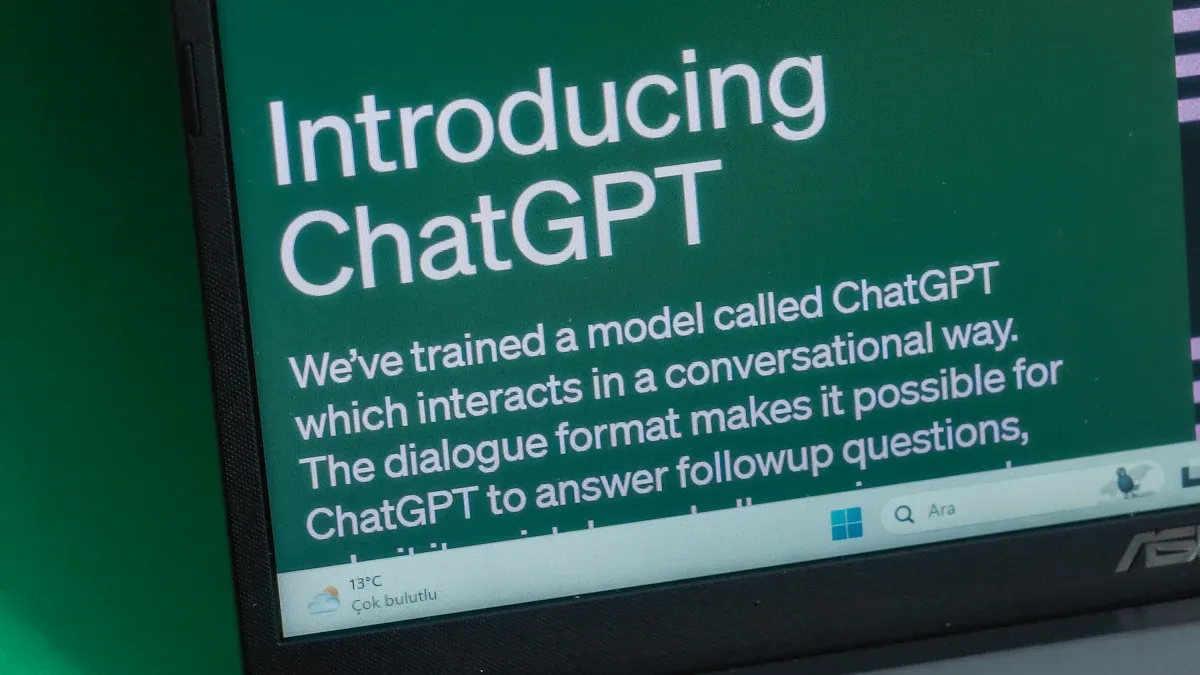
Imagine a world where businesses run smoother, and customer interactions feel tailor-made for you. Welcome to 2025, where language models drive innovation like turbocharged engines. With the AI market set to hit $244 billion, these models enhance your experience, from personalized ads to smarter logistics. Efficiency has never looked this good.
Key Takeaways
-
Language models are changing industries by making services better. They help improve healthcare, customer service, and delivery systems. Use them to stay ahead.
-
AI makes experiences more personal, keeping customers happy and loyal. Businesses should use language models to make interactions special for their audience.
-
Automating boring tasks helps people work faster and better. Companies save time and money by adding language models to their daily work.
Understanding Language Models and Their Evolution
What Are Language Models?
Picture a machine that can write essays, translate languages, or even answer your burning questions—all without breaking a sweat. That’s a language model for you! These AI-powered tools are trained on massive datasets of text and code, enabling them to understand and generate human-like language. Think of them as the Swiss Army knives of language processing.
Here’s a quick breakdown:
|
Definition |
Example |
|---|---|
|
A foundation model is a large-scale machine learning model trained on a broad dataset that can be adapted for various applications. |
GPT-3 and GPT-4, which power tools like ChatGPT, are prime examples. |
From generating creative content to assisting with customer support, these models are versatile and adaptable. They’re not just tools; they’re your AI-powered sidekicks.
The Evolution of Large Language Models
The journey of large language models is like a blockbuster movie—full of twists, turns, and jaw-dropping moments. It all started in the 1960s with ELIZA, the first chatbot. Fast forward to the 1970s, SHRDLU added context understanding. By the late 1980s, RNNs made sequential text processing possible. Then came the game-changers:
-
1997: LSTM networks improved how machines handled long-term dependencies.
-
2017: Transformers revolutionized NLP with attention mechanisms.
-
2018: BERT enhanced contextual understanding, while GPT-1 laid the groundwork for human-like text generation.
-
2020: GPT-3 introduced in-context learning, setting a new standard for large language models.
Today, these models boast multimodal capabilities, process images and videos, and even run on smaller devices thanks to Edge AI. The evolution isn’t just impressive—it’s mind-blowing.
Breakthroughs in AI Advancements by 2025
By 2025, AI has reached new heights, and language models are leading the charge. Small language models are now making waves in industries like robotics and medicine. Generative AI has unlocked tools tailored to solve specific problems, making technology more accessible than ever.
One standout innovation is DeepSeek, a cutting-edge language model rivaling giants like GPT-4. It excels in natural language processing, offering high-quality text generation and efficient task automation. Its open-source nature and cost-effectiveness make it a favorite for businesses looking to integrate AI into their workflows.
The future isn’t just here—it’s smarter, faster, and more connected than ever before.
Industry Transformation Through Language Models

Revolutionizing Customer Experience in Service Industries
Imagine walking into a hotel and being greeted by an AI concierge that knows your preferences better than you do. Large language models (LLMs) are reshaping customer experience in service industries by delivering hyper-personalized interactions. Whether it’s a chatbot that remembers your favorite coffee order or a virtual assistant that anticipates your travel needs, LLMs make every interaction feel tailored to you.
These models analyze vast amounts of data, including customer sentiment and past behaviors, to predict what you need before you even ask. For example, airlines now use LLMs to provide real-time updates on flight delays and offer alternative routes instantly. Restaurants leverage AI to recommend dishes based on your dietary preferences and mood. The result? A seamless experience that feels less like service and more like magic.
Tip: Businesses that embrace LLMs in customer service see higher satisfaction rates and stronger customer loyalty.
Enhancing Healthcare and Medical Research
Healthcare has entered a new era, thanks to artificial intelligence and language models. These tools streamline medical research and improve patient outcomes by automating complex tasks. Imagine doctors spending less time on paperwork and more time with patients. That’s the power of LLMs.
Take a look at the numbers:
|
Metric |
Improvement (%) |
|---|---|
|
Time spent for different patients |
|
|
Time spent among different trials |
32.4% to 60.2% |
|
Overall time saving for all patient-trial pairs |
42.6% |
LLMs analyze patient data to identify patterns, predict diagnoses, and recommend treatments. They also accelerate clinical trials by matching patients to studies in record time. Hospitals use AI-powered systems to monitor patient vitals and alert staff to potential emergencies. The result? Faster care, better outcomes, and a healthcare system that feels less like a maze and more like a well-oiled machine.
Transforming Marketing Strategies and Campaigns
Marketing has never been this smart—or this fun. LLMs are transforming campaigns by creating content that resonates with audiences on a deeper level. Forget generic ads; these models craft messages that speak directly to your interests and emotions.
Brands use LLMs to analyze customer sentiment, track trends, and predict what will grab attention. AI tools generate catchy slogans, engaging social media posts, and even entire ad campaigns. For example, a clothing brand might use LLMs to design personalized email campaigns based on your shopping history. The result? Marketing that feels less like a sales pitch and more like a conversation.
Note: Companies using AI-driven marketing strategies report higher engagement rates and better ROI.
Optimizing Logistics and Supply Chain Operations
The logistics world has embraced LLMs, and the transformation is nothing short of revolutionary. These models optimize operations by analyzing data from multiple sources, predicting trends, and automating decision-making.
Here’s how LLMs are making a difference:
-
Demand Forecasting: They enhance accuracy by incorporating external data and analyzing customer sentiment, leading to better inventory management.
-
Supplier Risk Management: They monitor supplier stability and identify emerging risks, allowing for proactive responses to disruptions.
-
Logistics Optimization: They optimize routes and predict maintenance needs, resulting in reduced costs and improved delivery efficiency.
Imagine a delivery truck that knows the fastest route, avoids traffic, and predicts when it’ll need a tune-up. That’s the power of LLMs in action.
Advancing Education and Personalized Learning
Education has become smarter, thanks to LLMs. These models adapt to individual student needs, creating personalized learning experiences that boost engagement and outcomes.
Here’s what LLMs bring to the table:
-
They analyze student performance and emotional cues to craft customized learning paths.
-
They facilitate continuous learning, ensuring students stay equipped with relevant knowledge.
-
They offer emotional support, helping students navigate challenges with confidence.
Studies show a 40% increase in students' emotional well-being when using AI-powered conversational systems. Platforms incorporating LLMs also improve peer communication skills by up to 28%. Imagine a classroom where every student feels heard, supported, and empowered to succeed. That’s the future of education with LLMs.
Key Use Cases of Language Models in 2025

Automating Repetitive and Administrative Tasks
Imagine a world where mundane tasks no longer eat up your time. Language models are turning this dream into reality by automating repetitive and administrative processes across industries. Whether it’s sorting resumes, scheduling interviews, or drafting marketing content, these AI-driven tools are the ultimate productivity boosters.
Take a look at how businesses are leveraging intelligent process automation:
|
Company/Organization |
Task Automation Description |
Productivity Gain/Impact |
|---|---|---|
|
Recruiters and HR Professionals |
Automating resume screening, candidate communication, and interview scheduling. |
Saves time by sorting applications and scheduling interviews automatically. |
|
Sage Publishing |
Leveraged generative AI for marketing over 100 new textbooks a year. |
Reduced content drafting time by 99% and saved 50% of marketing spend. |
|
JPMorgan Chase |
Implemented an AI tool for summarizing financial documents and reports. |
Supports knowledge sharing and data-driven decision-making for over 50,000 employees. |
|
Crexi |
Augmented sales processes using AI for email generation and lead follow-ups. |
Saved sales reps five hours daily, allowing 80% of their time to focus on customer engagement. |
|
Uber |
Integrated automated expense tracking in Uber for Business. |
Saved $170,000 in employee hours and minimized errors significantly. |
These examples highlight how language models streamline business processes, freeing you to focus on what truly matters—innovation and growth.
Personalizing Customer Interactions
Ever felt like a brand truly “gets” you? That’s the magic of personalization powered by large language models. These AI-driven tools analyze customer data to craft experiences that feel tailor-made. From personalized marketing emails to product recommendations that match your tastes, the customer-centric approach is redefining engagement.
Here’s why personalization matters:
-
Increased Engagement: You’re more likely to interact with content that feels relevant.
-
Higher Conversion Rates: Personalized offers and recommendations drive sales.
-
Enhanced Customer Loyalty: When you feel understood, you stick around.
For example, imagine receiving a curated playlist based on your mood or a shopping app suggesting items that complement your previous purchases. These AI-driven tools don’t just predict your needs—they anticipate them with uncanny accuracy. Personalized marketing campaigns are no longer a luxury; they’re a competitive advantage.
Supporting Data-Driven Decision-Making
Data is the lifeblood of modern businesses, and language models are the heart that pumps it into actionable insights. By analyzing vast datasets, these tools empower you to make smarter, faster decisions. Predictive analytics, powered by machine learning, helps businesses forecast trends, optimize strategies, and stay ahead of the curve.
Take JPMorgan Chase, for instance. Their AI tool summarizes financial documents, enabling employees to access data-driven insights effortlessly. This isn’t just about crunching numbers; it’s about transforming raw data into a roadmap for success. Whether you’re planning a marketing campaign or streamlining operations, language models ensure your decisions are backed by analytics and precision.
Enabling Real-Time Multilingual Communication
Language barriers? Not anymore. Language models are breaking down communication divides with real-time multilingual capabilities. Whether it’s a chatbot assisting customers in multiple languages or a virtual assistant bridging cultural gaps, these tools are revolutionizing global interactions.
Here’s how they’re making an impact:
|
Aspect |
Description |
|---|---|
|
Focus |
Enhancing multilingual language models for code-switched input data |
|
Application |
Real-world applications include chatbots, virtual assistants, and social media monitoring |
|
Impact |
Improves understanding of multilingual text and bridges communication divides in culturally mixed situations |
In healthcare, the stakes are even higher. Multilingual language models are addressing critical issues like language barriers between patients and providers.
|
Aspect |
Description |
|---|---|
|
Focus |
Building multilingual language models for medicine |
|
Problem Addressed |
Language barriers in healthcare leading to misunderstandings and inadequate care |
|
Solution |
Real-time translation and interpretation to facilitate effective communication between patients and providers |
These advancements aren’t just about convenience—they’re about creating a world where communication flows seamlessly, regardless of language or location.
Challenges and Ethical Considerations
Addressing Bias and Fairness in AI Outputs
Bias in artificial intelligence can feel like a bad plot twist—unexpected and frustrating. AI models sometimes perform better for certain groups, leaving others behind. For example, facial recognition algorithms often struggle with accuracy for Black individuals and women. Generative AI tools also amplify stereotypes, as seen in text-to-image models underrepresenting women in male-dominated jobs.
|
Issue |
Description |
|---|---|
|
Performance Discrepancies |
AI models excel for some demographics but falter for others. |
|
Reinforcement of Stereotypes |
Generative AI perpetuates biases, underrepresenting women in certain roles. |
Fairness metrics aim to fix these issues. Group-based metrics ensure equitable treatment across demographics, while individual fairness focuses on treating similar individuals similarly. However, balancing fairness with performance remains tricky. Weighted learning can improve fairness but may reduce overall accuracy.
Ensuring Data Privacy and Security
Data privacy isn’t just a buzzword—it’s your right. Regulations like GDPR and CCPA demand transparency and robust protection for personal data. Organizations must implement strict policies, secure AI systems, and conduct regular audits to stay compliant.
-
Develop clear data usage policies to define collection, storage, and sharing practices.
-
Use advanced security measures to protect data integrity.
-
Conduct regular audits to align with evolving regulations.
These measures ensure AI systems respect your privacy while maintaining trust.
Balancing Automation with Human Oversight
Automation is great, but it shouldn’t replace human judgment. AI enhances your abilities, especially in critical areas like security management. The human-in-the-loop approach combines human input with machine learning, improving accuracy and ethical alignment. This balance prevents mistakes and ensures AI systems reflect societal values.
Mitigating the Spread of Misinformation
Misinformation spreads faster than gossip at a family reunion. AI tackles this problem with real-time detection, external knowledge integration, and knowledge graphs. Post-training adjustments like prompt engineering and retrieval-augmented generation refine outputs. Transparency in content moderation systems ensures reliability.
-
Real-time monitoring systems catch misinformation early.
-
Multimodal fusion improves accuracy.
-
Biomedical knowledge graphs cross-check outputs for credibility.
These strategies create a safer digital space, where truth triumphs over falsehoods.
Language models in 2025 are reshaping your world in ways you never imagined.
-
They’re transforming industries, from coding to content creation, with multimodal capabilities.
-
Nearly 80% of jobs now see tasks influenced by these AI tools, boosting productivity by up to 56%.
-
Higher-income roles feel the shift most, sparking both innovation and new challenges.
The future? Smarter, faster, and undeniably exciting.
FAQ
What makes language models so powerful in 2025?
Language models analyze massive data, predict patterns, and generate human-like responses. They’re like your brain’s AI twin, but faster and always caffeinated. ☕
Can language models replace humans in creative tasks?
Not entirely! They assist with ideas and drafts, but your creativity adds the magic. Think of them as your brainstorming buddy, not your replacement.
Are language models safe to use for sensitive tasks?
Yes, but only if you ensure proper safeguards. Use encryption, audits, and ethical practices to keep your data secure and your AI trustworthy.








